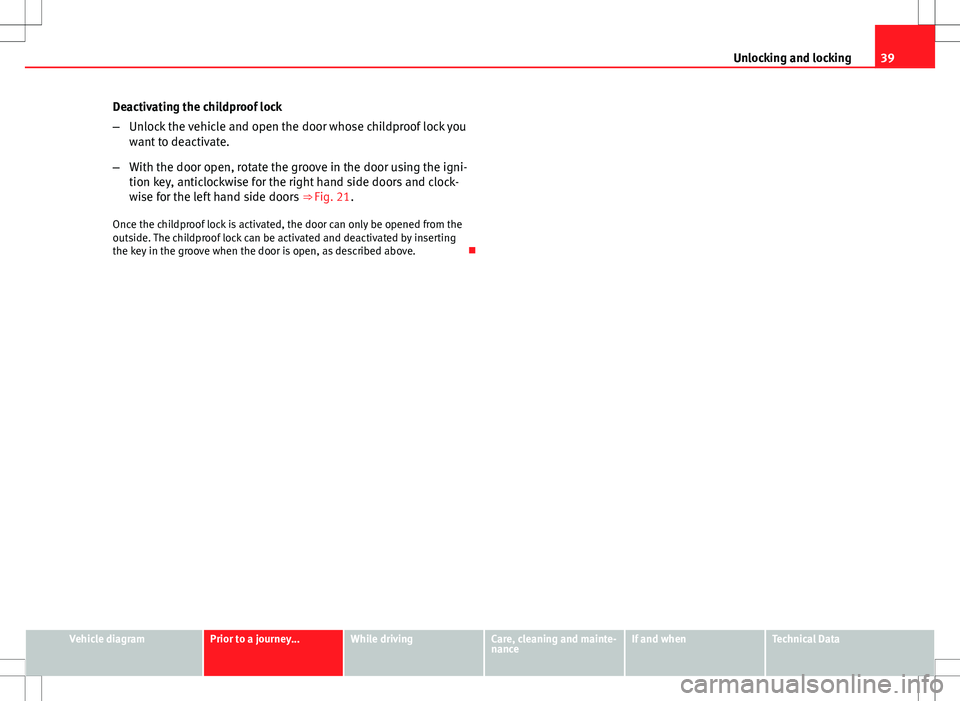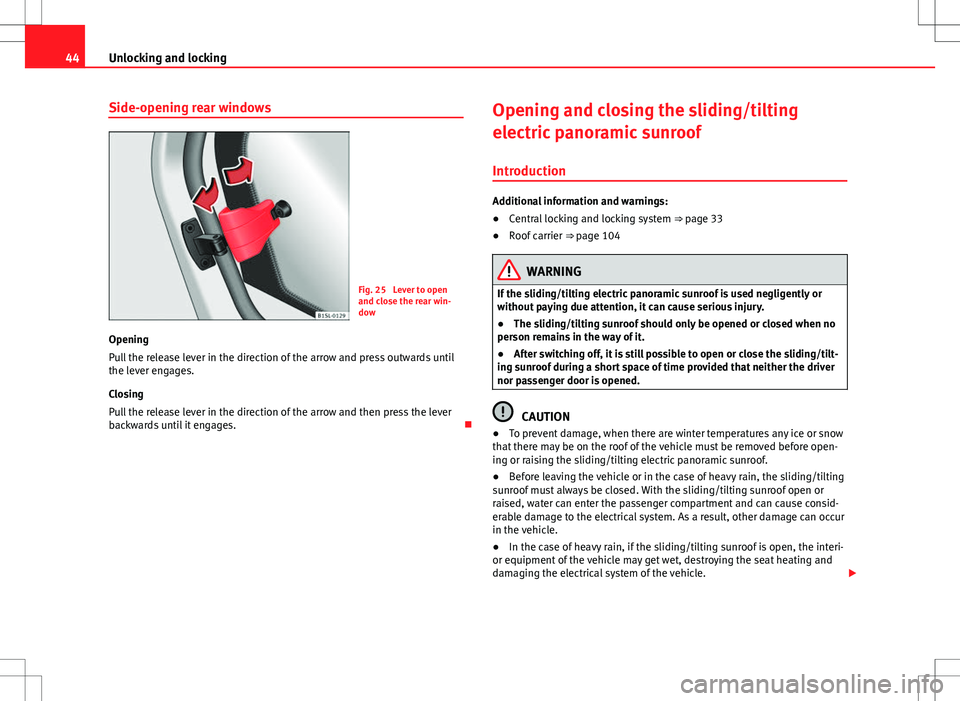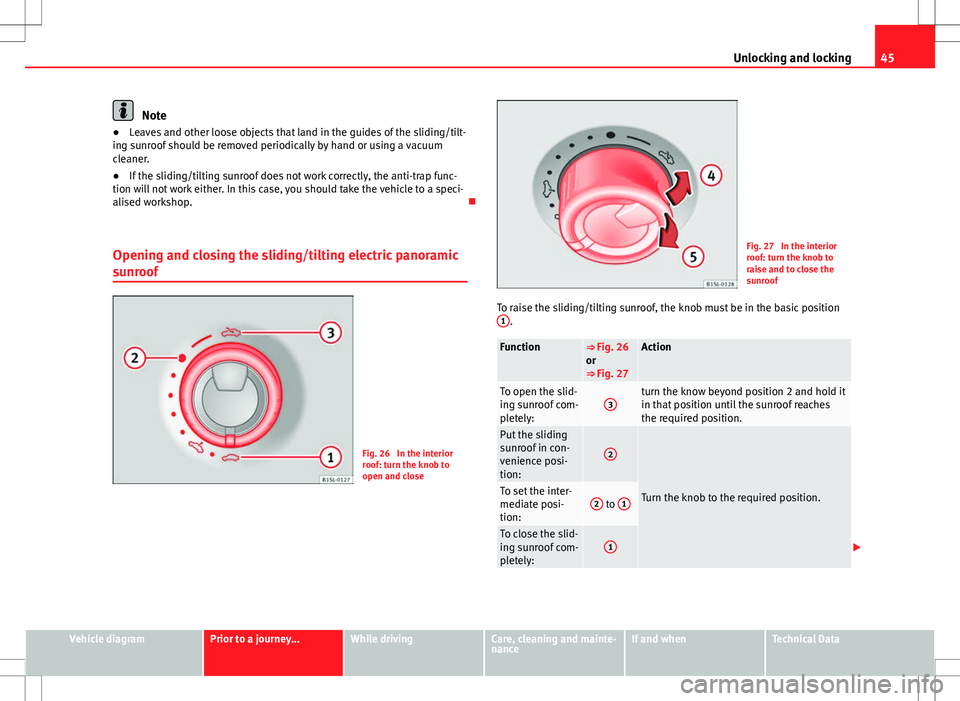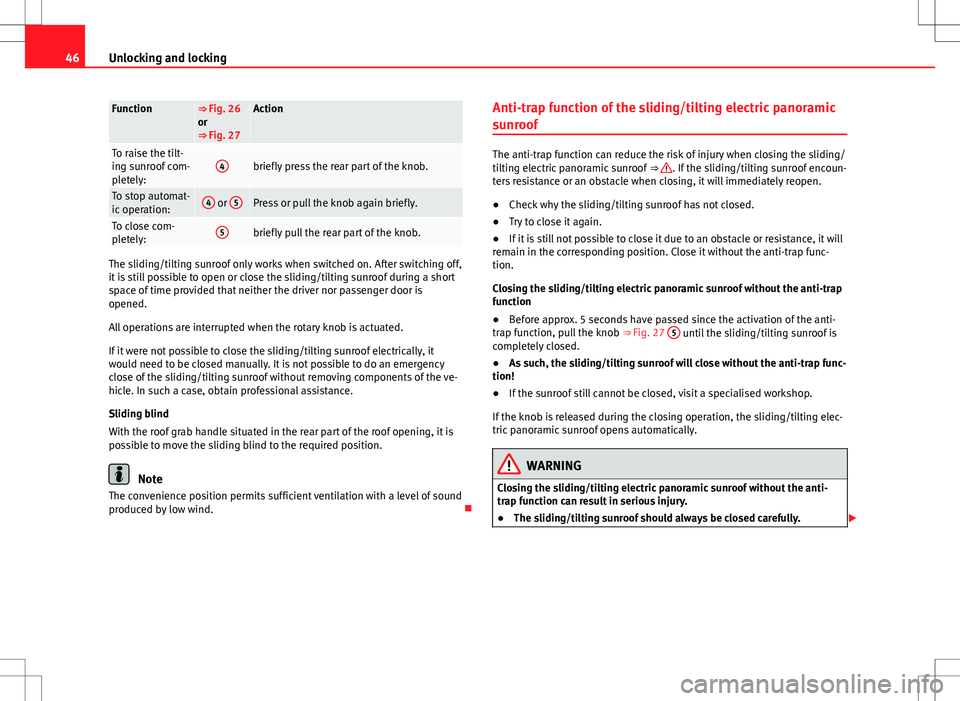Seat Mii 2012 Service Manual
Manufacturer: SEAT, Model Year: 2012, Model line: Mii, Model: Seat Mii 2012Pages: 308, PDF Size: 4.13 MB
Page 41 of 308

39
Unlocking and locking
Deactivating the childproof lock
– Unlock the vehicle and open the door whose childproof lock you
want to deactivate.
– With the door open, rotate the groove in the door using the igni-
tion key, anticlockwise for the right hand side doors and clock-
wise for the left hand side doors ⇒ Fig. 21.
Once the childproof lock is activated, the door can only be opened from the
outside. The childproof lock can be activated and deactivated by inserting
the key in the groove when the door is open, as described above.
Vehicle diagramPrior to a journey...While drivingCare, cleaning and mainte-
nanceIf and whenTechnical Data
Page 42 of 308

40Unlocking and locking
Rear lid
Introduction
Additional information and warnings:
● Exterior detail ⇒ page 6
● Central locking ⇒ page 33
● Transporting ⇒ page 97
● Emergency locking and unlocking ⇒ page 243
WARNING
Careless and unsuitable locking, opening and closing of the rear lid can
cause accidents and serious injury.
● Open and close the rear lid only when nobody is in the way.
● Do not close the rear lid by pushing it down with your hand on the
rear window. The rear window could break and cause injury.
● Ensure the rear lid is closed and locked correctly after closing, other-
wise, it may open unexpectedly while driving. A closed rear lid should be
flush with the corresponding parts of the bodywork.
● Always keep the rear lid closed while driving to avoid toxic gases en-
tering the interior.
● Do not open the rear lid when there is a load installed, for example a
carrier system. Likewise, the rear lid cannot be opened when a load is at-
tached to it, for example bicycles. An open rear lid could close itself if
there is an additional weight on it. If necessary, press down on the rear
lid and remove the load.
● Close and lock both the rear lid and all the other doors when you are
not using the vehicle. Ensure that nobody remains inside the vehicle.
WARNING (Continued)
● Never allow children to play inside or around the vehicle without su-
pervision, especially if the rear lid is open. Children could enter the lug-
gage compartment, close the rear lid and become trapped. Depending on
the time of the year, temperatures inside a locked and closed vehicle can
be extremely high or extremely low resulting in serious injuries and ill-
ness or even death, particularly for young children.
● Never leave children or disabled people alone in the vehicle. If the ve-
hicle key or the central locking button is used, they may be locked in the
vehicle.
CAUTION
Before opening the rear lid, ensure that there is sufficient free space to
open and close it, for example if you are in a garage.
Note
On the display of the Portable Navigation System (supplied by SEAT)
⇒ page 222 can be seen if the rear lid has been left open or is not correctly
shut.
Page 43 of 308

41
Unlocking and locking
Opening the rear lid
Fig. 22 On the vehicle
key: Button to unlock and
open the rear lid
If there are bicycles attached to a carrier situated on the rear lid, in some
cases, it may not automatically open ⇒
. Remove the load from the carrier
and support the open rear lid.
Opening with central locking
● Press the button
on the vehicle key
⇒ Fig. 22 for about one second
to unlock the rear lid.
● ALTERNATIVELY: Press the button
on the vehicle key until the rear lid
opens automatically several centimetres.
● Opening the rear lid with the button.
Opening with the vehicle mechanical key
● Insert the vehicle key into the lock cylinder of the driver door and turn
the key in an anticlockwise direction
⇒ page 33.
● Opening the rear lid with the button.
WARNING
Unsuitable or careless unlocking and opening of the rear lid could cause
serious injuries.
● If there is a loaded luggage carrier on the rear lid, it could be un-
locked or open but not recognised as such. An unlocked or open rear lid
could open unexpectedly while driving.
Note
At outside temperatures of less than 0 °C (+32 °F), the pressurised gas
struts cannot always automatically lift the tailgate. In this case, open the
rear lid manually.
Closing the rear lid
Fig. 23 Rear lid open:
hand grip
Vehicle diagramPrior to a journey...While drivingCare, cleaning and mainte-
nanceIf and whenTechnical Data
Page 44 of 308

42Unlocking and locking
Closing the rear lid
● Grab the handgrip inside the rear lid ⇒ Fig. 23 (arrow).
● Push the rear lid downwards until it locks into place in the lock.
● Ensure that it is correctly closed by pulling on it firmly.
Locking the rear lid with central locking*
If the vehicle is unlocked and no doors or the rear lid are opened during
about. 30 seconds, it will automatically lock again. This function prevents
the vehicle from remaining unlocked if the unlocking button is pressed by
mistake.
Locking is only possible when the rear lid is correctly and fully closed.
● The rear lid is also locked by a central locking.
● If the vehicle rear lid is locked or unlocked using the
button, when it
is closed once more it will lock automatically.
● A closed but not locked rear lid will lock automatically at a speed above
about 9 km/h (6 mph).
Locking the rear lid with the vehicle mechanical key
Locking is only possible when the rear lid is correctly and fully closed.
● Insert the vehicle key into the lock cylinder of the driver door and turn
the key in a clockwise direction ⇒ page 33.
WARNING
Unsuitable or careless closing and locking of the rear lid could cause se-
rious injuries.
● Never leave the vehicle unattended, and never allow children to play
inside or around the vehicle without supervision, especially if the rear lid
is open. Children could enter the luggage compartment, close the rear lid
and become trapped. A locked vehicle can be subjected to extremely high
and low temperatures, depending on the time of year, thus causing seri-
ous injuries/illness and even death.
Note
Before closing the rear lid, make sure that the key has not been left inside
the boot.
Page 45 of 308

43
Unlocking and locking
Windows Introduction
Additional information and warnings:
● SEAT information system ⇒ page 22
● Central locking and locking system ⇒ page 33
WARNING
Careless use of the electric windows can cause serious injury.
● Only operate the electric windows when nobody is in the way.
● Never leave children or disabled people alone in the vehicle if the
doors are to be locked. The windows cannot be opened in case of an
emergency.
● Always take all the keys with you whenever you leave the vehicle. Af-
ter turning off the ignition, the windows can be opened and closed for a
short time using the buttons on the door as long as the driver door or
passenger side door is not open.
CAUTION
When the windows are open, rain can enter into the vehicle, dampening the
interior equipment and causing damage to the vehicle. Opening and closing the electric windows
Fig. 24 In the driver
door: electric windows
button
Opening and closing the windows
FunctionNecessary operationsOpening:Press button .Closing:Push the button .
Vehicle diagramPrior to a journey...While drivingCare, cleaning and mainte-
nanceIf and whenTechnical Data
Page 46 of 308

44Unlocking and locking
Side-opening rear windows
Fig. 25 Lever to open
and close the rear win-
dow
Opening
Pull the release lever in the direction of the arrow and press outwards until
the lever engages.
Closing
Pull the release lever in the direction of the arrow and then press the lever
backwards until it engages. Opening and closing the sliding/tilting
electric panoramic sunroof
Introduction
Additional information and warnings:
● Central locking and locking system ⇒ page 33
● Roof carrier ⇒ page 104
WARNING
If the sliding/tilting electric panoramic sunroof is used negligently or
without paying due attention, it can cause serious injury.
● The sliding/tilting sunroof should only be opened or closed when no
person remains in the way of it.
● After switching off, it is still possible to open or close the sliding/tilt-
ing sunroof during a short space of time provided that neither the driver
nor passenger door is opened.
CAUTION
● To prevent damage, when there are winter temperatures any ice or snow
that there may be on the roof of the vehicle must be removed before open-
ing or raising the sliding/tilting electric panoramic sunroof.
● Before leaving the vehicle or in the case of heavy rain, the sliding/tilting
sunroof must always be closed. With the sliding/tilting sunroof open or
raised, water can enter the passenger compartment and can cause consid-
erable damage to the electrical system. As a result, other damage can occur
in the vehicle.
● In the case of heavy rain, if the sliding/tilting sunroof is open, the interi-
or equipment of the vehicle may get wet, destroying the seat heating and
damaging the electrical system of the vehicle.
Page 47 of 308

45
Unlocking and locking
Note
● Leaves and other loose objects that land in the guides of the sliding/tilt-
ing sunroof should be removed periodically by hand or using a vacuum
cleaner.
● If the sliding/tilting sunroof does not work correctly, the anti-trap func-
tion will not work either. In this case, you should take the vehicle to a speci-
alised workshop.
Opening and closing the sliding/tilting electric panoramic
sunroof
Fig. 26 In the interior
roof: turn the knob to
open and close
Fig. 27 In the interior
roof: turn the knob to
raise and to close the
sunroof
To raise the sliding/tilting sunroof, the knob must be in the basic position 1
.
Function⇒ Fig. 26
or
⇒ Fig. 27Action
To open the slid-
ing sunroof com-
pletely:3turn the know beyond position 2 and hold it
in that position until the sunroof reaches
the required position.
Put the sliding
sunroof in con-
venience posi-
tion:
2
Turn the knob to the required position.To set the inter-
mediate posi-
tion:2 to 1
To close the slid-
ing sunroof com-
pletely:1
Vehicle diagramPrior to a journey...While drivingCare, cleaning and mainte-
nanceIf and whenTechnical Data
Page 48 of 308

46Unlocking and locking
Function⇒ Fig. 26
or
⇒ Fig. 27Action
To raise the tilt-
ing sunroof com-
pletely:4briefly press the rear part of the knob.
To stop automat-
ic operation:4 or 5Press or pull the knob again briefly.
To close com-
pletely:5briefly pull the rear part of the knob.
The sliding/tilting sunroof only works when switched on. After switching off,
it is still possible to open or close the sliding/tilting sunroof during a short
space of time provided that neither the driver nor passenger door is
opened.
All operations are interrupted when the rotary knob is actuated.
If it were not possible to close the sliding/tilting sunroof electrically, it
would need to be closed manually. It is not possible to do an emergency
close of the sliding/tilting sunroof without removing components of the ve-
hicle. In such a case, obtain professional assistance.
Sliding blind
With the roof grab handle situated in the rear part of the roof opening, it is
possible to move the sliding blind to the required position.
Note
The convenience position permits sufficient ventilation with a level of sound
produced by low wind. Anti-trap function of the sliding/tilting electric panoramic
sunroof
The anti-trap function can reduce the risk of injury when closing the sliding/
tilting electric panoramic sunroof
⇒ . If the sliding/tilting sunroof encoun-
ters resistance or an obstacle when closing, it will immediately reopen.
● Check why the sliding/tilting sunroof has not closed.
● Try to close it again.
● If it is still not possible to close it due to an obstacle or resistance, it will
remain in the corresponding position. Close it without the anti-trap func-
tion.
Closing the sliding/tilting electric panoramic sunroof without the anti-trap
function
● Before approx. 5 seconds have passed since the activation of the anti-
trap function, pull the knob ⇒ Fig. 27 5
until the sliding/tilting sunroof is
completely closed.
● As such, the sliding/tilting sunroof will close without the anti-trap func-
tion!
● If the sunroof still cannot be closed, visit a specialised workshop.
If the knob is released during the closing operation, the sliding/tilting elec-
tric panoramic sunroof opens automatically.
WARNING
Closing the sliding/tilting electric panoramic sunroof without the anti-
trap function can result in serious injury.
● The sliding/tilting sunroof should always be closed carefully.
Page 49 of 308

47
Unlocking and locking
WARNING (Continued)
● No person should ever remain in the way of the sliding/tilting sun-
roof, especially when closing without the anti-trap function.
● The anti-trap function does not prevent fingers or other parts of the
body from becoming trapped against the roof frame and injuries occur-
ring.
Vehicle diagramPrior to a journey...While drivingCare, cleaning and mainte-
nanceIf and whenTechnical Data
Page 50 of 308

48Ensuring you are correctly and safely seated
Ensuring you are correctly and safely seated
Adjusting the seat position
Introduction
Number of seats
The vehicle has a total of 4 seats: 2 front seats and 2 rear seats. Each seat is
equipped with a seat belt.
Additional information and warnings:
● Seat functions ⇒ page 55
● Seat belts ⇒ page 57
● Airbag system ⇒ page 67
● Child seats (accessories) ⇒ page 76
WARNING
An incorrect sitting position in the vehicle can lead to severe injuries or
death in the event of sudden braking or manoeuvres, collision or acci-
dents or if the airbag deploys.
● Before the vehicle moves, assume the proper sitting position and
maintain it throughout the trip. This also includes fastening the seat
belt.
● Never transport more people than there are seats with a seat belt
available in the vehicle.
WARNING (Continued)
● Children must always be protected with an approved child restraint
system suited to their height and weight ⇒ page 76, ⇒ page 67.
● Always keep your feet in the footwell while the vehicle is in motion.
Never, for example, put your feet on the surface of a seat or on the dash
panel and never put them out of a window. Otherwise the airbag and seat
belt offer insufficient protection and the risk of injury in the event of an
accident is increased.
WARNING
Before every trip, adjust the seat, the seat belt and the head restraints
and instruct your passengers to fasten their seat belts properly.
● Move the front passenger seat back as far as possible.
● Adjust the driver seat so that there is at least 25 cm distance between
your chest and the hub of the steering wheel. Adjust the driver seat so
that you are able to press the accelerator, brake and clutch pedals to the
floor with your knees slightly angled and that the distance between your
knees and the dash panel is at least 10 cm. If your physical constitution
prevents you from meeting these requirements, contact a Specialised
workshop to make any modifications required.
● Never drive with the backrest tilted far back. The further the backrests
are tilted to the rear, the greater the risk of injury due to incorrect posi-
tioning of the belt web or to the incorrect sitting position.
● Never drive with the backrest tilted forwards. Should a front airbag
deploy, it could throw the backrest backwards and injure the passengers
of the rear seats.
● Sit as far away as possible from the steering wheel and the dash pan-
el.